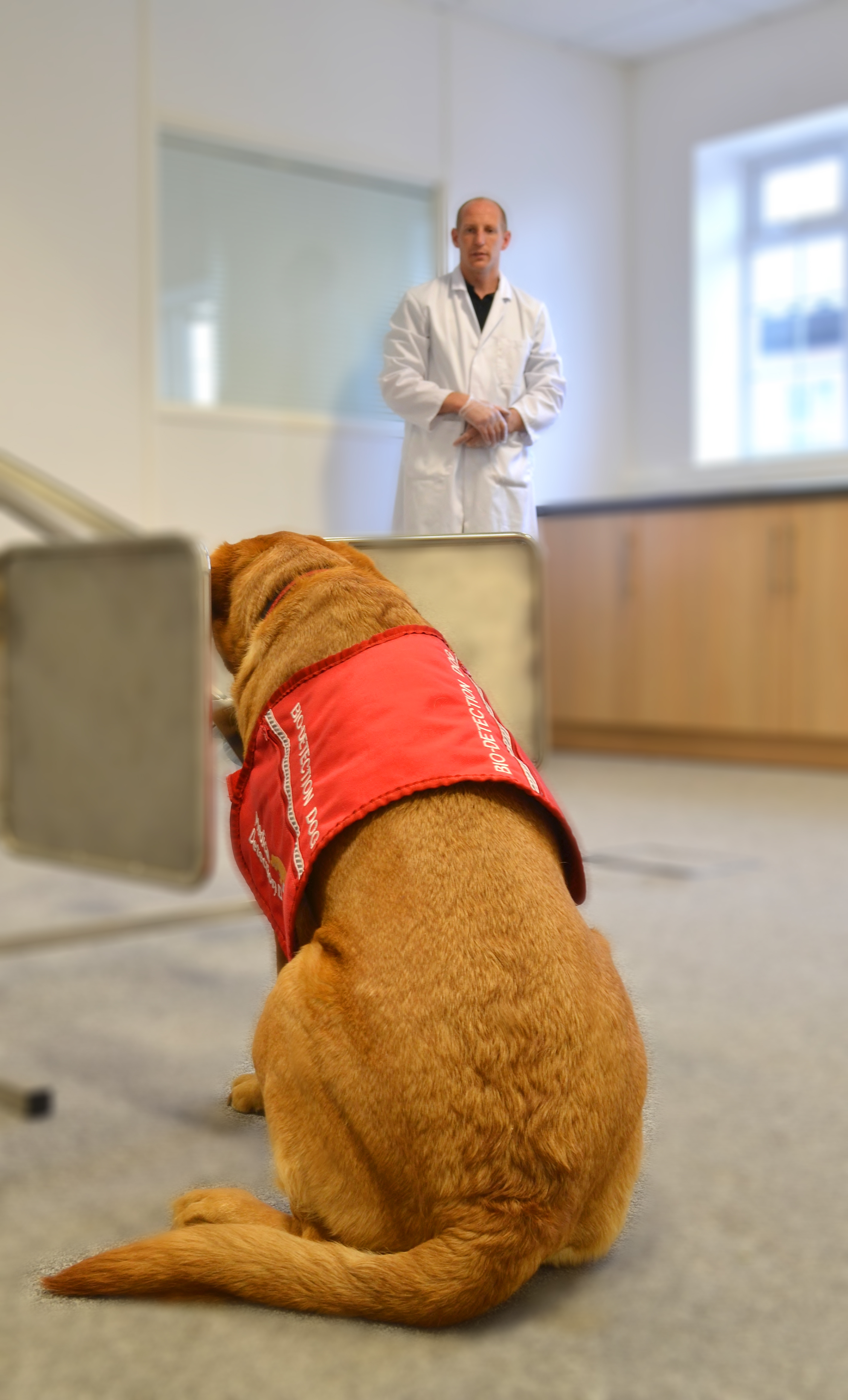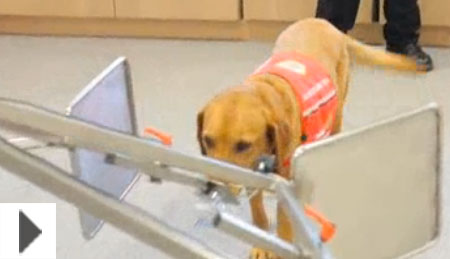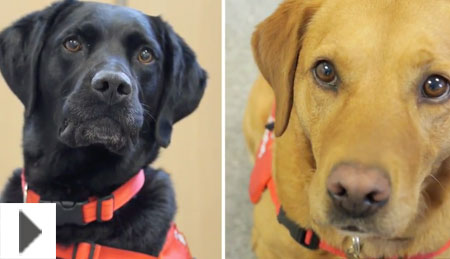
The scientific basis of the ability of dogs to detect the odour of cancer is believed to be linked to volatile organic compounds produced by malignant cells. It has been established that during tumour growth changes occur in some of the cellular proteins, leading to peroxidation of the cell membrane components, which then produces volatile organic compounds that can be detected in the headspace of the cells.
There is strong indication from a number of studies that these cancer volatiles are excreted in urine or exhaled on the breath at an early stage in the disease process.
The first clinically robust investigation of cancer detection by dogs was reported by Willis and colleagues (British Medical Journal 2004). During this study, dogs were trained by individuals from Medical Detection Dogs (aka Cancer and Bio-detection Dogs) to detect bladder cancer (transitional cell carcinoma) by smelling urine samples from patients and healthy controls. Six dogs of varying breeds were used, none of which had been trained for previous scent work. Overall diagnostic accuracy was 41% (compared with the 14% success rate expected from chance alone). However there was considerable variation in the success rate between dogs, the best dog achieving 56%, but two dogs having no success at all.
The charity, in collaboration with Willis et al, published a further study in The Journal of Cancer Biomarkers 2011, ‘Volatile organic compounds as biomarkers of bladder cancer: Sensitivity and specificity using trained sniffer dogs’. Specificity ranged from 92% for urine samples obtained from young, healthy volunteers, decreasing to 56% for samples taken from older patients with non-cancerous urological disease.
Supporting evidence has been published around the world including a study by Cornu and colleagues (European Urology 2011), ‘Olfactory Detection of Prostate Cancer by Dogs Sniffing Urine: A Step Forward in Early Diagnosis’, indicated the possibilities of canine cancer detection (sensitivity 91%, specificity 91%). A second study published online in 2011 by Sonoda and colleagues investigated colorectal cancer screening using faecal samples, and demonstrated equally promising results (sensitivity 97%, specificity 99%).
A recent study from Italy (Taverna et al, Journal of Urology 2014), reported the diagnostic accuracy of dogs trained to recognise specific volatile organic compounds of prostate cancer in urine samples (sensitivity 98–100%; specificity 98–99%).
Ehmann et al (European Respiratory Journal, 2012) carried out the first published study showing that sniffer dogs can reliably detect lung cancer from a breath sample (sensitivity 71% specificity 93%).
Medical Detection Dogs’ Publications
Bistre Dabbah, S., Mendl, M. T., Guest, C. & Rooney, N. J., 9 Apr 2025, In PLOS ONE 20(4).
Trained dogs can detect canine urothelial carcinoma of the bladder – 6 December 2024.
Desmas-Bazelle, I., Rooney, N.J., Morant, S. Guest, C. et al. Trained dogs can detect canine urothelial carcinoma of the bladder. Vet. Oncol. 1, 12 (2024). https://doi.org/10.1186/s44356-024-00012-1
Survey on the importance of different traits for medical detection dogs – 11 November 2024.
Bistre Dabbah S, Mendl M, Guest C, Rooney N. (2024). Survey on the importance of different traits for medical detection dogs. Doi:10.1016/j.jveb.2024.08.004.
Parr-Cortes, Z., Müller, C.T., Talas, L.Mendl M, Guest C, Rooney N J. (2024). The odour of an unfamiliar stressed or relaxed person affects dogs’ responses to a cognitive bias test. Sci Rep 14, 15843 (2024). Doi:10.1038/s41598-024-66147-1
Expert considerations and consensus for using dogs to detect human SARS-CoV-2-infections 08 December 2022
Claire Guest, MSc, Sarah Y Dewhirst, PhD, Steve W Lindsay, PhD, David J Allen, PhD, Sophie Aziz, MSc, Oliver Baerenbold, PhD, John Bradley, PhD, Unnati Chabildas, MRes, Vanessa Chen-Hussey, PhD, Samuel Clifford, PhD, Luke Cottis, BVMS, Jessica Dennehy, MSc, Erin Foley, MSc, Salvador A Gezan, PhD, Tim Gibson, PhD, Courtenay K Greaves, MSc, Immo Kleinschmidt, PhD, Sébastien Lambert, PhD, Anna Last, PhD, Steve Morant, PhD, Josephine E A Parker, PhD, John Pickett, PhD, Billy J Quilty, MSc, Ann Rooney, MSc, Manil Shah, MSc, Mark Somerville, Chelci Squires, BSc, Martin Walker, PhD, James G Logan, PhD, COVID Dogs Research Team. April 2022 “Using trained dogs and organic semi-conducting sensors to identify asymptomatic and mild SARS-CoV-2 infections: an observational study.” PMID: 35325195 PMCID: PMC9047163 DOI: 10.1093/jtm/taac043
Davies JC, Alton E, Simbo A, Murphy R, Seth I, Williams K, Somerville M, Jolly L, Morant S, and Guest C., (2019) Training dogs to differentiate Pseudomonas aeruginosa from other cystic fibrosis bacterial pathogens: not to be sniffed at?. Eur Respir J 2019 54: 1900970; DOI: 10.1183/13993003.00970-2019
Guest, C.M., Doggett, M., Dewhirst, S., D’Alessandro, U., Kandeh, B., Morant, S.V., Pinder, M., Squires, C., Logan, J.G. and Lindsay, S.W. (2019) “Trained dogs identify people with malaria parasites by their odour” Letter in Lancet Infectious Diseases vol 19, Issue 6, p578-580 June 2019 DOI:https://doi.org/10.1016/S1473-3099(19)30220-8
Wilson. C., Morant, S., Kane, S., Pesterfield, C., Guest, C., N.J. Rooney., (2019) “An Owner-Independent Investigation of Diabetes Alert Dog Performance”. Frontiers in Veterinary Science 6:91. doi: 10.3389/fvets.2019.00091
Rooney, N.J., Guest, C.M., Swanson, L.C. and Morant, S.V., (2019). “How effective are trained dogs at alerting their owners to changes in blood glycaemic levels?: Variations in performance of glycaemia alert dogs.” PloS one, 14(1), p.e0210092. https://doi.org/10.1371/journal.pone.0210092
Concha, A.R., Guest, C.M., Harris, R., Pike, T., Feugier, A., Zulch, H. and Mills, D.S., (2018). “Canine Olfactory Thresholds to Amyl Acetate in a Biomedical Detection Scenario”. Frontiers in Veterinary Science, 5, p.345. https://doi.org/10.3389/fvets.2018.00345
Concha, A., Mills, D.S., Feugier, A., Zulch, H., Guest, C., Harris, R. and Pike, T.W., (2014). “Using sniffing behaviour to differentiate true negative from false negative responses in trained scent-detection dogs”. Chemical senses, 39(9), pp.749-754. https://doi.org/10.1093/chemse/bju045
Rooney, N.J., Morant, S. and Guest, C., (2013). “Investigation into the value of trained glycaemia alert dogs to clients with type I diabetes”. PloS one, 8(8), p.e69921. doi: 10.1371/journal.pone.0069921
Willis, C.M., Church, S.M., Guest, C.M., Cook, W.A., McCarthy, N., Bransbury, A.J., Church, M.R. and Church, J.C., (2004). “Olfactory detection of human bladder cancer by dogs: proof of principle study”. BMJ, 329(7468), p.712. doi: https://doi.org/10.1136/bmj.329.7468.712
Church, J. and Williams, H., (2001). “Another sniffer dog for the clinic?” The Lancet, 358(9285), p.930. DOI:https://doi.org/10.1016/S0140-6736(01)06065-2
Dr Claire Guest also authored the following papers when at Hearing Dogs:
Guest, C.M., Collis, G.M. and McNicholas, J., (2006). “Hearing dogs: A longitudinal study of social and psychological effects on deaf and hard-of-hearing recipients”. Journal of Deaf Studies and Deaf Education, 11(2), pp.252-261. https://doi.org/10.1093/deafed/enj028
References
Canine Olfactory Detection of Human Disease: References:
Bijland LR, Bomers MK, Smulders YM. et al. Smelling the diagnosis: a review on the use of scent in diagnosing disease. Neth J Med. 2013,71:300-307. http://www.ncbi.nlm.nih.gov/pubmed/23956311
Boedeker E, Friedel G, Walles T. et al.Sniffer dogs as part of a bimodal bionic research approach to develop a lung cancer screening. Interact Cardiovasc Thorac Surg. 2012, May,14(5):511-5. doi: 10.1093/icvts/ivr070.http://www.ncbi.nlm.nih.gov/pubmed/22345057
Bomers K, M; van Agtmael A, Michiel; et al. Using a dog’s superior olfactory sensitivity to identify Clostridium difficile in stools and patients: proof of principle study. BMJ 2012, 345:e7396http://www.bmj.com/content/345/bmj.e7396
Buszewski B, Ligor T, Jezierski T; et al. Identification of volatile lung cancer markers by gas chromatography-mass spectrometry: comparison with discrimination by canines. Analytical Bioanalytical Chemistry. 2012, Jul;404(1):141-6. doi: 10.1007/s00216-012-6102-8. http://www.ncbi.nlm.nih.gov/pmc/articles/PMC3389235/
Church J, Williams H. et al. Another sniffer dog for the clinic? Lancet 2001,Sept. 15;358:930.
http://www.thelancet.com/journals/lancet/article/PIIS0140-6736(01)06065-2/fulltext Concha, A., Mills, D.S., Feugier, A., Zulch, H., Guest, C., Harris, R., Pike, T.W. (2014). Using Sniffing Behavior to Differentiate True Negative from False Negative Responses in Trained Scent-Detection Dogs. Chemical Senses,Sept. 2014.
Cornu J-N et al. Olfactory Detection of Prostate Cancer by Dogs Sniffing Urine: A Step Forward in Early Diagnosis Eur Urol (2010) http://www.europeanurology.com/article/S0302-2838(10)00998-X/fulltext
Currie CJ, et al. Evaluation of the impact of hypoglycaemia on health care resource use, productivity, fear of hypoglycaemia and health utility in a UK population. Diabetologica 2004,47 : A323 2004.
Ehmann R. Boedeker E. Friedrich U. et al. European Respiratory Journal, Canine scent detection in the diagnosis of lung cancer: revisiting a puzzling phenomenon. European Respiratory Journal, 2012 March, vol. 39 no. 3 669-676 http://erj.ersjournals.com/content/39/3/669.abstract
Haick H, Broza YY, Mochalski P, et al. Assessment, origin, and implementation of breath volatile cancer markers.Chem Soc Rev. 2014 epub, DOI: 10.1039/c3cs60329f
Horvath G, Andersson H, Nemes S. Cancer odor in the blood of ovarian cancer patients: a retrospective study of detection by dogs during treatment, 3 and 6 months afterward. BMC Cancer. 2013;13:396. doi: 10.1186/1471-2407-13-396. http://www.ncbi.nlm.nih.gov/pubmed/23978091
Kirton A, Winter A, Wirrell, E, et al. Seizure response dogs: Evaluation of a formal training program, Epilepsy & Behavior 2008,13 (3) 499-504.http://dravet.is/fs/Uppl%C3%BDsingar%20um%20flogahunda/Seizure%20response%20dogs.pdf
Mancini, C., Harris, R., Aengenheister, B., Guest, C. (2015). Re-Centering Multispecies Practices: a Canine Interface for Cancer Detection Dogs, 33rd International ACM CHI Conference on Human Factors in Computing Systems, ACM CHI’15, ACM Press, pp. 2673-2682.
McCulloch M, Jezierski T, Broffman M, et al. Diagnostic accuracy of canine scent detection in early- and late-stage lung and breast cancers. Integrative Cancer Therapies. 2006; 5:30-9. http://www.ncbi.nlm.nih.gov/pubmed/16484712
McCulloch,M; Turner,K; Broffman, M; Lung cancer detection by canine scent: will there be a lab in the lab?European Respiratory Journal. 2012 vol.39 no 3 http://erj.ersjournals.com/content/39/3/511.extract
Moser, E; McCulloch M. Canine scent detection of human cancers: A review of methods and accuracy. Journal of Veterinary Behaviour Clinical Applications and Research. 2010 May, Vol 5, Issue 3, 145-152,http://www.journalvetbehavior.com/article/S1558-7878(10)00003-1/abstract
Pickel D, Manucy GP, Walker DB, et al. Evidence for canine olfactory detection of melanoma Applied Animal Behaviour Science, 2004 89(1-2): 107-116 http://ict.sagepub.com/content/5/1/30.refs
Poling, Alan; Weetjens, Bart J, et al. Using Giant African Pouched Rats to Detect Tuberculosis in Human Sputum Samples: 2009 Findings. Am.J.Trop> Med.Hyg., 83(6) 2010,pp. 1308 – 1310
http://www.ajtmh.org/content/83/6/1308.abstract
Rooney N J, Morant S, Guest CM et al. Investigation into the value of trained glycaemia alert dogs to clients with Type I diabetes PLOS ONE 2013, Aug, 10.1371/journal.pone.0069921
http://www.plosone.org/article/info%3Adoi%2F10.1371%2Fjournal.pone.0069921 Sonoda H, Kohnoe S, Yamazato T, et al. Colorectal cancer screening with odour material by canine scent detection Gut 2011, 60:814-819. doi 10.1136/gut.2010.218305http://gut.bmj.com/content/early/2011/01/17/gut.2010.218305.full.pdf Taverna G, Tidu L, Grizzi F, et al. Olfactory System of Highly Trained Dogs Detects Prostate Cancer in Urine Samples. 2014, Sep 28. pii: S0022-5347(14)04573-X. doi: 10.1016/j.juro.2014.09.099. http://www.pubfacts.com/detail/25264338/Olfactory-System-of-Highly-Trained-Dogs-Detects-Prostate-Cancer-in-Urine-Samples. Waggoner LP, Jones M, Williams M, et al. Effects of extraneous odors on canine detection. Enforcement and Securities Technologies, Proc. SPIE, 1998 vol. 3575, 355-62. Weber C M.; Cauchi M; Patel, et al. Evaluation of a gas sensor array and pattern recognition for the identification of bladder cancer from urine headspace. Analyst 2011 136(2), pp. 359-364 http://pubs.rsc.org/en/Content/ArticleLanding/2011/AN/c0an00382d#!divAbstract Wells DL, Lawson SW, Siriwardena AN. Canine Responses to Hypoglycaemia in Patients with Type 1 DiabetesJournal of Alternative and Complementary Medicine 2008, 14 (10 ): 1235-1241. http://www.ncbi.nlm.nih.gov/pubmed/19040375 Williams H, Pembroke A. Sniffer dogs in the melanoma clinic? Lancet. April 1, 1989;1:734), http://www.sciencedirect.com/science/article/pii/S0140673689922575 Willis CM, Church SM, Guest CM, et al: Olfactory detection of human bladder cancer by dogs: proof of principle study. British Medical Journal 2004, 329: 712-714.
http://www.ncbi.nlm.nih.gov/pubmed/15388612
Willis CM, Britton LE, Harris R, Wallace J, Guest CM. Volatile organic compounds as biomarkers of bladder cancer: Sensitivity and specificity using trained sniffer dogs. Cancer Biomark. 2010/11; 8: 145-53.
http://www.ncbi.nlm.nih.gov/pubmed/22012770
Assistance Dogs International. http://www.assistancedogsinternational.org
Assistance Dogs UK. http://www.assistancedogs.org.uk
Electronic noses
In Israel, in a joint venture between the Technion-Israel Institute of Technology and Alpha Szenszor, The ™NA-NOSE, sensor was developed. The ™Na-Nose explicitly sought to duplicate the dogs experience with technology following the results of the BMJ paper in 2004. This sensor is able to detect lung cancer through exhaled breath.
The Odoreader® from Bristol Urological Institute and Liverpool University is a direct result of the BMJ paper in 2004 and is able to help detect and diagnose early stage bladder cancer.
Determining accuracy
- Sensitivity relates to the ability of the test to correctly identify a positive result, i.e. sick people correctly identified as being sick.
- Specificity relates to the ability of the test to correctly identify negative results, i.e. people without the disease correctly identified as being without the disease.
Figures 1 and 2 (below) illustrate unpublished training data for the correct detection of bladder cancer samples and non-bladder cancer samples by Cancer Detection Dog Daisy. The bar charts refer to test samples that were used for training purposes, including non-blinded, single-blinded and double-blinded runs. Many of these samples were shown to the dog on more than one occasion, to enable the dog to learn to detect a particular scent. The accuracy rate for an individual dog may be much lower in a true test situation, i.e. when the dog is trying to detect previously undiagnosed samples of cancer.
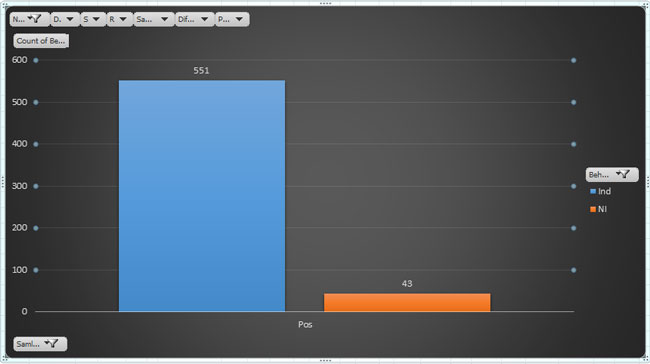
The blue bar represents samples that were correctly indicated by the dog as positive cancer samples (551/594). The orange bar represents positive cancer samples that were not indicated by the dog in error (i.e. did have the disease but were not indicated by the dog as having the disease; 43/594).
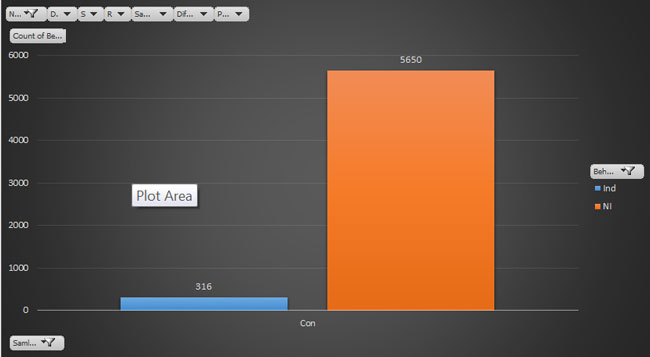
The orange bar represents samples that were correctly ignored by the dog (i.e. did not have the disease; 5650/5966). The blue bar represents samples that were indicated as being positive by the dog in error (i.e. did not have the disease but were indicated by the dog as having the disease; 316/5966).
This training data corresponds with the publications mentioned earlier. Medical Detection Dogs are now embarking on further studies with much larger, and double-blind, samples to determine current accuracy, for which we will seek peer review.
Our experience since the first study in 2004 has enabled us to refine training methods and consequently improve success rates with a number of dogs.
What are the dogs detecting?
Dogs with their incredible sense of smell can detect the minute odours now understood to be associated with many cancers. As yet we do not know exactly what it is the dogs can smell because they cannot tell us what markers they are sensing.
Funding opportunities
Medical Detection Dogs is accepting funding applications from collaborators looking to explore the potential of animals to detect human disease through odour to improve diagnosis for the patient and support improvement in the management of long-term health conditions.
Please email [email protected] for more information.

